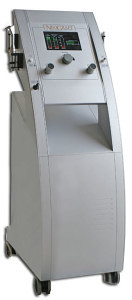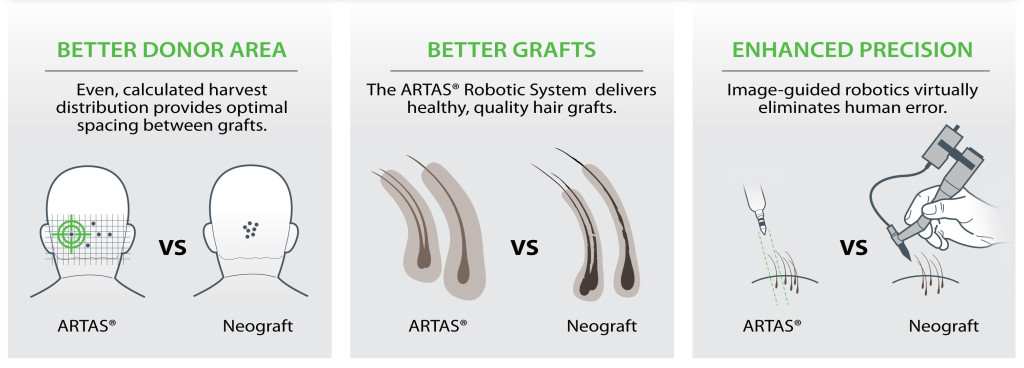The NeoGraft™ machine for Follicular Unit Extraction (FUE) hair transplant surgery is a hand-held surgical device that extracts follicular units from the donor area and implants them in the recipient area via an air-pressure/suction-based system. The machine is partially automated; however, it is not a robotic system. The NeoGraft instrument does not have the precision of the computer-driven image-guided system that guides the ARTAS® Robot for FUE.
The Neograft machine relies on manual control provided by a human operator in order to select and extract follicular unit grafts. Whereas robotic hair transplant surgery delivers a high rate of healthy follicular unit grafts regardless of the operator, the Neograft device for FUE is susceptible to human error, imprecise graft extraction, variations due to the speed and skill level of the physician, and a higher transection rate of extracted follicles.
Neograft vs. ARTAS Robot
How Neograft Works
The Neograft hand-held device is applied to the scalp where it first separates the grafts from the surrounding donor tissue with a rotating sharp punch that is connected to a suction unit. Once the upper part of the graft is dissected by the punch, the suction pulls the graft out, separating it from the remaining tissue. Since the graft is still attached at its base, suction can shear the graft and remove the protective tissue (deep dermis and fat) that normally surrounds this portion of the graft. This results in increased graft fragility and a greater risk of desiccation (drying) and mechanical trauma both in the extraction step and in the final step of the FUE procedure, graft placement.
- More about Follicular Unit Extraction
Once the graft is separated from the tissue, it is sucked through a tube into a small chamber. This process has the advantage of not requiring a technician to manually remove the graft from the scalp, but the disadvantage of exposing the grafts to rapidly moving dry air that is continually rushing through the tubing and chamber. Subjecting the grafts to these conditions adds further risk of injury from desiccation.
Once approximately 50 grafts are extracted from the scalp through manual excision and suction, the collection chamber is opened and the harvested grafts are placed, by hand, into a Petri dish that contains a saline holding solution. Recipient sites, where the grafts are placed after they are harvested, are created in the donor area of the scalp using traditional instruments, such as a hypodermic needle or scalpel.
In the placement phase of a hair transplant using Neograft, a small number of extracted grafts are removed from the holding solution and a second arm of the Neograft machine is used to draw up the grafts (via suction). One at a time, the grafts are sucked into the needle-tipped device. They are then individually injected into the recipient sites using air pressure. Because the grafts are literally pushed into the site using air pressure, there is no way to assure that the grafts are properly positioned in the site and that the base of each follicle is not folded on itself.
Limitations of the Neograft Machine
The suction function of the Neograft machine introduces two risks not present with either manual or the more advanced robotic FUE techniques:
- The suction has a tendency to strip the surrounding tissue from the lower portion of the grafts during their removal, exposing them to drying injury
- The vacuum creates a continuous flow of dry air around the harvested grafts, further exposing them to drying injury.
The combined actions of stripping the lower portion of protective tissue from the grafts and exposing them to the drying action of fast-moving air, present a potentially serious problem for graft survival. In a landmark study by Dr. Marcelo Gandelman — “Light and electron microscopic analysis of controlled injury to follicular unit grafts” — it was shown that the drying of grafts during hair transplant surgery caused more severe injury than mechanical trauma and was more likely to be a cause of poor growth.
The Neograft, using a single, sharp cutting tip, does not have the follicle-sparing capabilities of the two-step (sharp-blunt) technologies that both the manual S.A.F.E. System and the ARTAS robotic system are based upon.
Like other manual FUE instrumentation, the effectiveness of the Neograft machine is highly dependent upon operator skill. The robotic system for FUE, the ARTAS Robot, on the other hand is less dependent on the skill or speed of the physician in the extraction part of the procedure and, in fact, can increase its accuracy and performance. It doesn’t, however, obviate the need for physician judgment and skill in performing this and the other steps of the FUE hair transplant. Although Neograft instrument — years in development — incorporated a number of innovative ideas into the field of hair transplantation, there are several aspects of the design that may compromise graft survival. It is questionable if the Neograft machine, in its current form, has the ability to consistently produce high quality grafts.
ARTAS Robot vs. Neograft
| ARTAS Robot | Neograft | |
| System | Robotic precision, consistency enables accurate reproducible harvesting with intact graft rates >92% | Hand-held dermal punch drill with foot-pedal activation susceptible to operator variability and high hair damage rates |
| Graft Quality | Grafts with protective tissue rendering them less subject to injury | Grafts vulnerable to handling damage and drying that may compromise survival |
| Digital Mapping | Real-time 3D digital analysis of hair follicle characteristics enables selection of best available hair for harvesting | None |
| Dissection & Technique | Two-needle blunt dissection technique produces minimal scarring with the ability to harvest many hairs per graft
Intelligent algorithms optimize alignment and dissection depths for effective harvest of intact follicular unit grafts Healthy grafts removed directly from scalp and placed in preservation media to promote graft survival |
Very small sharp punches dissect fewer hairs per graft resulting in less hairs that are harvested from the donor area
Very small sharp punches with manual alignment increase likelihood of hair transection compromising survival Vacuum suction of follicular unit grafts exposes them to possibility of desiccation and may harm survival |







